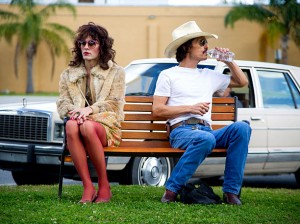Sex on the rocky, French beach
Apparently, one of the reasons Stranger by the Lake has been of such interest to film writers and culture bloggers is the sex. Alain Guiraudie’s extremely French sex thriller is being listed along with Blue Is the Warmest Color and Interior. Leather Bar as part of an art film trend of explicit and not always necessary sex. The criticism of this trend is that the sex doesn’t add to the story or characterization or even the mood, and while I think that’s sometimes the case (as in I Want Your Love), it certainly was not in Blue nor with Stranger by the Lake. In fact, while the sex in Stranger is titillating and sexy, it is also occasionally creepy and it always is necessary for the propulsion of the plot and the creation of authenticity. The movie does, after all, take place at a gay cruising spot, a rocky beach on a lake in rural France. The men are mostly naked and most of them go into the woods to have sex with each other – or to watch other men have sex with each other. Not showing the sex these men share would be bluntly censorious and dishonest.
And the power of lust is at the heart of Stranger by the Lake. Franck (Pierre Deladonchamps), a lithe and beautiful young man, comes to the beach every day to swim and cruise men and he is infatuated with a mustachioed man named Michel (Christophe Paou) who has a particularly skillful freestyle stroke and a clingy boyfriend. Franck also comes to talk to a heavy older man named Henri (Patrick d’Assumçao), who, unlike Franck, doesn’t see himself as gay, but rather as a man who always has a women and sometimes has sex with men. Franck is confused because Henri has no interest in cruising or swimming, but Franck clearly finds value in Henri’s vague pronouncements about the ways to live correctly.
One evening, after spending the afternoon having sex with a man in the woods, Franck watches Michel and his boyfriend swimming in the lake. Then arguing. And then Michel drowning his boyfriend before calmly swimming to the shore, dressing, and driving away. Franck does nothing, and the next day, both Franck and Michel are back at the beach. Michel starts flirting with Franck, and despite some apprehension, he returns the affection and they begin to have regular trysts every afternoon. Still, Franck clearly worries that Michel will do to him what he did to his previous lover.
The strange and almost cynical morality of the characters and the ever increasing tension about Michel’s potential make what at first seems like a bland sex comedy into something much more complex, metaphorical, and even epic. One critic’s theory is based on the seeming 1980s clothes and cars; the callous way the men on the beach treat each other and their seeming death drive are Guiraudie’s commentary on the early years of AIDS. But it’s hard to know what Guiraudie is doing, whether it is an existentialist homage to Camus’s The Outside or just the story of how far lust and connection can warp a man’s moral compass. The lack of clarity in the Guiraudie’s message makes the film’s sex less hot and more disconcerting, but also, oddly, more powerful.
Guiraudie’s spare, slow-burn script and ambiguous themes are matched by his stunning and simple photography, which manage to make the simplest refractions off of the lake and the shadows thrown by tree branches into art. His cast of mostly unknowns are impeccably directed as well. Deladonchamps is both appalling and endearing, while Paou is actually sexy enough that I could imagine (if not agree with) Franck ignoring Michel’s murderousness. The discomforting nature of their relationship is much more fascinating and surprising than their sex, even though that is pretty fun to watch, too.
Stranger by the Lake
Written and Directed by Alain Guiraudie
Starring Pierre Deladonchamps, Christophe Paou, and Patrick d’Assumçao
Not Rated
Opens March 14 at Landmark Hillcrest


